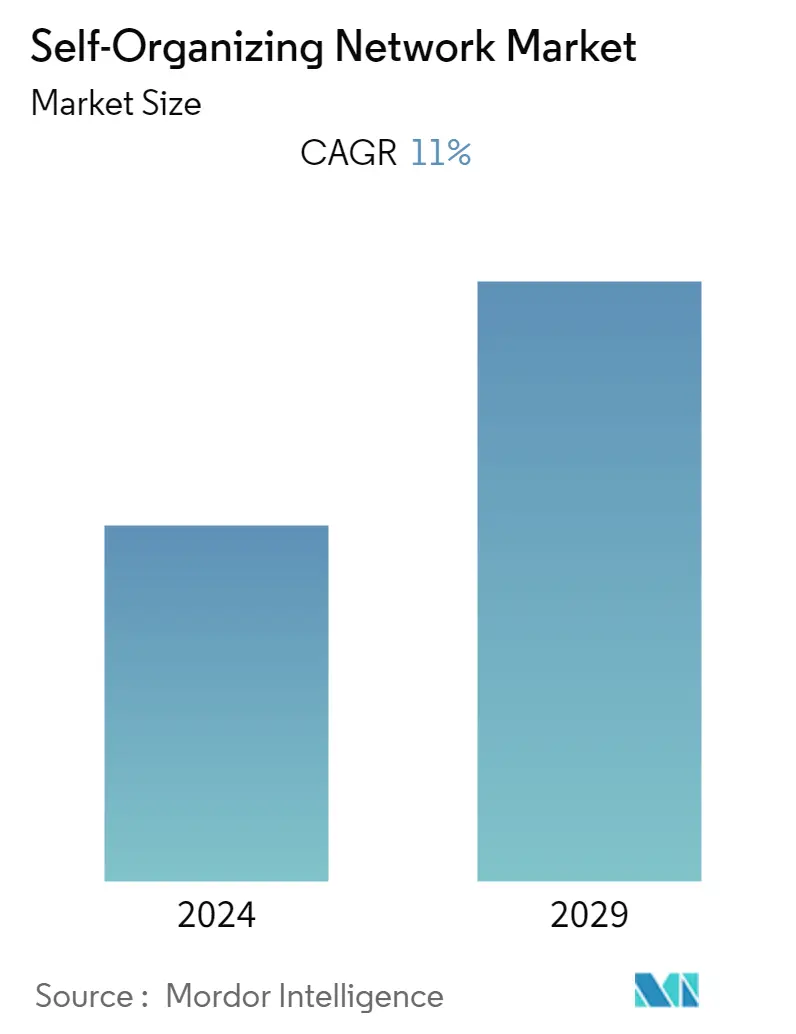Market Size of Self-Organizing Network Industry

| Study Period | 2019 - 2029 |
| Base Year For Estimation | 2023 |
| CAGR | 11.00 % |
| Fastest Growing Market | Asia-Pacific |
| Largest Market | Europe |
| Market Concentration | Medium |
Major Players
*Disclaimer: Major Players sorted in no particular order |
Self-Organizing Network Market Analysis
Self-Organizing Network Market revenue is expected to grow at a CAGR of 11.0% over the next five years. A Self-Organizing Network (SON) is a mobile software solution that manipulates complex network operations to deliver enhanced network performance. It is designed to plan, manage, diagnose, and troubleshoot network errors through advanced automated configurations.
- Growing urbanization and demand for advanced systems to manage network complexities is one of the main factors driving the market growth. SON offers effective network traffic management, lower operating costs, and improved customer satisfaction. Furthermore, SON simplifies and streamlines the management of multi-technology and multi-vendor networks, allowing providers to deliver faster services at a lower cost.
- The significant growth in information technology (IT) infrastructure and vast telecommunications expenditures are expected to boost the market growth. For Instance, Ericsson recently announced that Becker Mining Systems AG had inked a multi-country reselling deal with Ericsson to market and supply Ericsson Private 5G and Ericsson Private Networks to the mining sector.
- The 5G network implementation is substantially more complicated, and this will facilitate a need for improved operations and OSS (Operations support systems). The Self-Organizing Network (SON) is included as part of the network framework as a critical driver for enhancing OSS for LTE and 5G systems. It indicates that SON will have a significant positive impact on network operations.
- For instance, Verizon's innovation on VRAN (Virtualized Radio Access Network) plans to deploy over 8,000 virtualized cell sites, with a target of delivering over 20,000 by the end of 2025. The transition to a cloud-based, virtualized architecture with standardized interfaces in every part of the network leads to better flexibility, faster service delivery, higher scalability, and improved network cost efficiency. Such initiatives from the key players in the market would create new growth opportunities for the Self-Organizing Network market.
- During the COVID-19 scenario, most people preferred work-from-home mode, thus increasing high-speed Internet services demand. Post COVID-19, the 5G subscription penetration is further growing and thus creating new growth opportunities for the Self-Oraganizing Network market.
Self-Organizing Network Industry Segmentation
A self-organizing network (SON) is an automation technology that simplifies mobile radio access networks' planning, configuration, management, optimization, and healing.
Self-Organizing Network Market is segmented by offering (software, services), by architecture (C-SON, D-SON, H-SON), by network technology (2G/3G, 4G/LTE, 5G), and geography (North America, Europe, Asia-Pacific, Latin America, Middle East, and Africa). The market sizes and forecasts are in value (USD million) for all the above segments.
| By Offering | |
| Software | |
| Services |
| By Architecture | |
| C-SON | |
| D-SON | |
| H-SON |
| By Network Technology | |
| 2G/3G | |
| 4G/LTE | |
| 5G |
Self-Organizing Network Market Size Summary
The Self-Organizing Network (SON) market is poised for significant growth, driven by the increasing complexity of network operations and the demand for advanced management systems. SON technology, which enhances network performance through automated configurations, is becoming essential as urbanization and digital transformation accelerate. The market is benefiting from the expansion of IT infrastructure and telecommunications investments, with key players like Ericsson and Verizon leading initiatives to integrate SON into 5G and LTE systems. These developments are expected to streamline network management, reduce operational costs, and improve service delivery, creating new opportunities for market expansion.
The demand for SON is further fueled by the rapid adoption of 5G technology and the need for efficient handling of growing wireless connections. Strategic partnerships, acquisitions, and investments by major companies such as Qualcomm and VMware are enhancing market dynamics and facilitating the transition to cloud-based, virtualized network architectures. The Asia-Pacific region, in particular, is witnessing increased internet penetration and mobile data traffic, driven by planned LTE and 5G deployments. This regional growth, coupled with global trends, underscores the market's potential as it adapts to the evolving landscape of high-speed connectivity and digital services.
Self-Organizing Network Market Size - Table of Contents
-
1. MARKET INSIGHTS
-
1.1 Market Overview
-
1.2 Industry Attractiveness - Porter's Five Forces Analysis
-
1.2.1 Bargaining Power of Suppliers
-
1.2.2 Bargaining Power of Consumers
-
1.2.3 Threat of New Entrants
-
1.2.4 Threat of Substitute Products
-
1.2.5 Intensity of Competitive Rivalry
-
-
1.3 Impact of COVID-19 on the Market
-
-
2. MARKET SEGMENTATION
-
2.1 By Offering
-
2.1.1 Software
-
2.1.2 Services
-
-
2.2 By Architecture
-
2.2.1 C-SON
-
2.2.2 D-SON
-
2.2.3 H-SON
-
-
2.3 By Network Technology
-
2.3.1 2G/3G
-
2.3.2 4G/LTE
-
2.3.3 5G
-
-
Self-Organizing Network Market Size FAQs
What is the current Self-Organizing Network Market size?
The Self-Organizing Network Market is projected to register a CAGR of 11% during the forecast period (2024-2029)
Who are the key players in Self-Organizing Network Market?
Ericsson, Airhop Communications, Cisco Systems, Huawei Technologies and Commscope are the major companies operating in the Self-Organizing Network Market.

